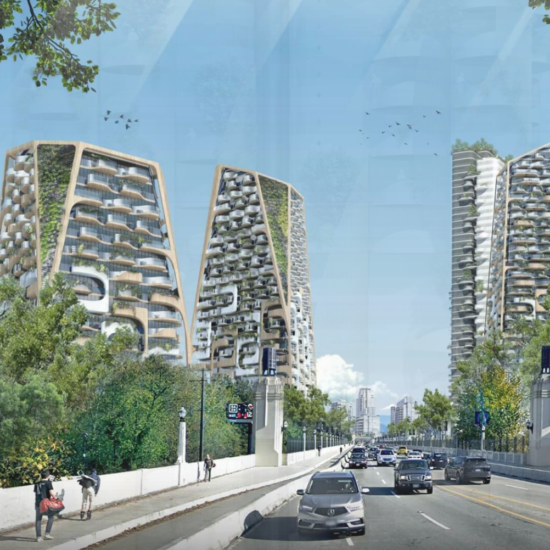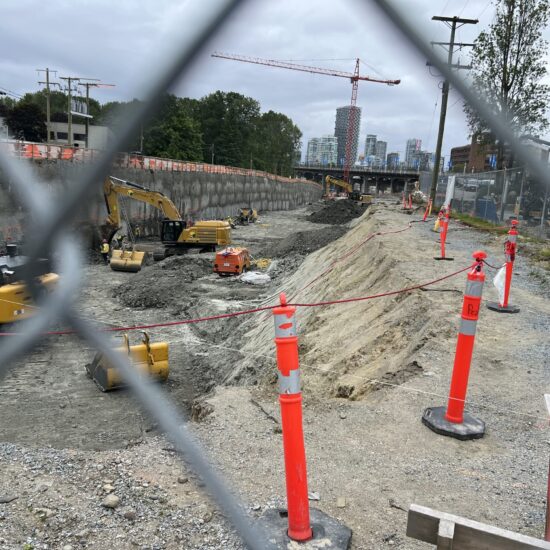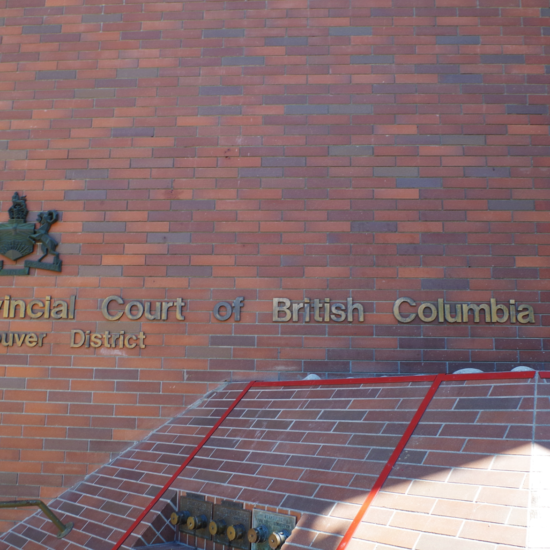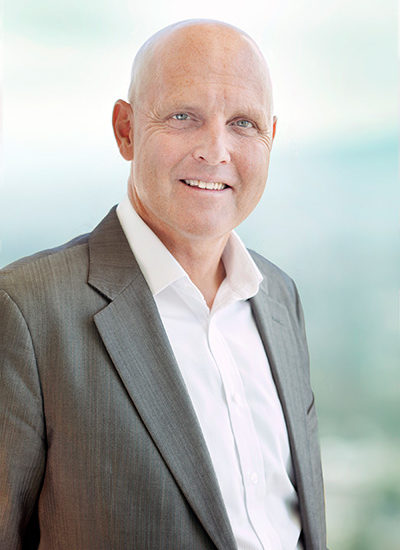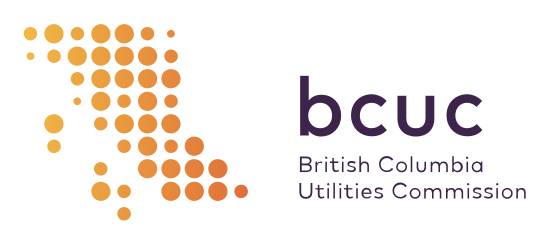
Bob Mackin
A B.C. Utilities Commission (BCUC) tribunal has given approval to Creative Energy Senakw LP (CESLP) for a thermal energy system to heat and cool the first two phases of towers on Squamish Nation land beside the Burrard Bridge.
The Oct. 26 decision allows CESLP to build a power plant in a parkade to be constructed next to Chestnut Street, on the west of the Senakw site, for more than $30 million. CESLP will operate the low carbon electrified energy system for its only customer, developer Nch’kay West, with electric chillers and heat captured from Metro Vancouver sewage.
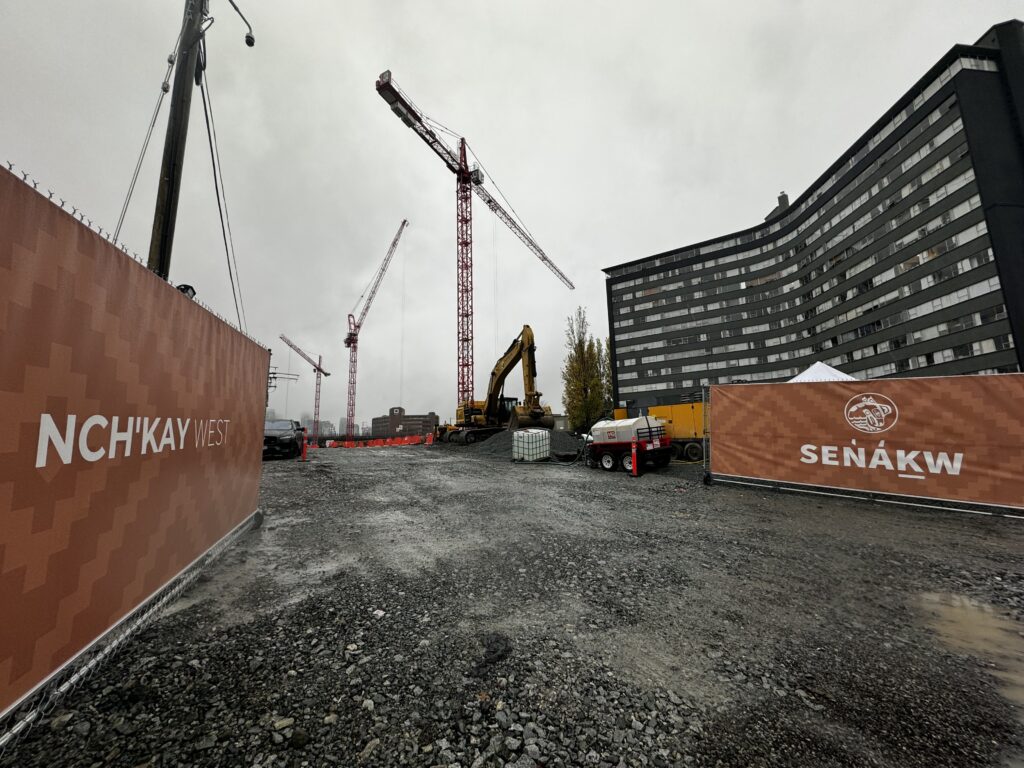
Chestnut entrance to the Senakw construction site (Mackin)
The BCUC tribunal was chaired by commissioner Carolann Brewer, a lawyer from the Smalqmix first nation, with commissioners Anna Fung and Blair Lockhart.
The system is expected to be in service by February 2025 and the seven residential towers are scheduled to be occupied between 2025 and 2027. CESLP originally applied Oct. 20, 2022 for the certificate of public convenience and necessity.
“The panel finds a need for low carbon heating and cooling for the Senakw development,” said the decision. “Further, of the low carbon technologies that CESLP evaluated including biomass and ocean heat recovery, the panel agrees with CESLP’s conclusion that sewer heat recovery is the most reasonable alternative to meet the developer’s requirement for a low carbon energy system.”
CESLP satisfied a key requirement of the application when it filed its agreement with Metro Vancouver on Sept. 18.
“Under the terms of the sewage diversion agreement, there is no cost for the waste heat, subject only to heat policy changes by Metro Vancouver, in which case parties have three years to negotiate rates,” said the BCUC decision. “If no agreement is reached within that time either party can terminate the agreement.”
The agreement includes escape clauses for either party, subject to three years notice, during the first 20 years of the agreement.
“The panel finds that the Senakw [district energy system] is properly sized to meet forecast demand, and that it includes a justifiable level of redundancy for heating. In addition, the panel finds that CESLP has appropriately identified key risks and adequately addressed them, in particular the risks associated with construction costs and fuel availability,” said the decision.
CESLP’s design engineer, Stantec, retained consultant BTY Group to estimate the cost of project construction at $26.4 million in 2022 dollars or $30.026 million when the project is fully in operation and servicing phases one and two.
Residential Consumer Intervener Association (RCIA) was the sole intervener registered. Kits Point Residents Association (KPRA) and the Squamish Nation provided two letters of comment during the proceeding. The Squamish Nation disagreed with the BCUC decision to hold a hearing. KPRA said there had been a lack of public consultation — there was but one public meeting, on Oct. 3, 2022. KPRA also expressed various concerns about odour and noise from the plant, impacts on the neighbourhood and Vanier Park, and whether Metro Vancouver would receive fair compensation.
The tribunal called KPRA’s concerns about neighbourhood impacts “rather unspecific.” It ruled that CESLP had addressed KPRA concerns on noise and odour because CESLP said the system was a closed loop and primarily underground.
“Public engagement on the Senakw DES was included in the description of the Senakw development, and while KPRA has raised concerns in relation to engagement, the DES is clearly not the focal point for public concern,” the tribunal said.
In late September, B.C. Supreme Court Justice Carla Forth dismissed the KPRA bid to quash the City of Vancouver’s 120-year agreement to service the Senakw project. The agreement had been negotiated and agreed behind closed doors, without public consultation. But Forth decided the agreement was valid, the city acted within the law and that no civic official acted in bad faith.
The federally approved project is slated to contain 6,000 residential units by 2030. At the groundbreaking ceremony in September 2022, Prime Minister Justin Trudeau announced a $1.4 billion loan through Canada Mortgage and Housing Corporation to finance half the units in the first two phases. It is officially a partnership between Westbank Corp. and the Squamish Nation’s Nch’kay Development Corp.
A 2019 expert report for Squamish Nation members estimated the project could bring as much as $12.7 billion cashflow for the band and developer.
Support theBreaker.news for as low as $2 a month on Patreon. Find out how. Click here.







